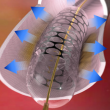Courtesy of Dr. Agustín Vecchia. The aim of this study was to compare the safety and efficacy of bioresorbable everolimus eluting scaffolds (BVS) vs. everolimus eluting stents (EES) in patients with ischemic heart disease. Medline, Embase, the Cochrane Central Register of Controlled Trials (CENTRAL), was searched for scientific sessions, abstracts, and relevant websites for<a href="https://solaci.org/en/2016/01/19/meta-analysis-of-bioresorbable-vascular-scaffolds-vs-everolimus-eluting-stents/" title="Read more" >...</a>
IMPROVE-IT: The combination simvastatin / ezetimibe reduces post SCA events
This work included 18144 patients from 39 countries that were admitted pursuing an acute coronary syndrome (with or without ST segment elevation) randomized 1: 1 to receive the combination of simvastatin 40 mg / ezetimibe 10 mg (n = 9067) or simvastatin 40 mg alone (n = 9077). Of the total, 88% received a coronary<a href="https://solaci.org/en/2015/06/24/improve-it-the-combination-simvastatin-ezetimibe-reduces-post-sca-events/" title="Read more" >...</a>
Mitral valve repair in moderate ischemic mitral regurgitation
Article Up to 50% of acute myocardial infarctions are associated to mitral regurgitation of some degree and 10% of these cases present, at least, moderate regurgitation. Ischemic mitral regurgitation is associated to an increase of mortality and morbidity. For surgical patients with moderate regurgitation, the benefits mitral valve repair remain unclear. 301 patients were randomized<a href="https://solaci.org/en/2015/06/24/mitral-valve-repair-in-moderate-ischemic-mitral-regurgitation/" title="Read more" >...</a>
MITOCARE: TRO40303 intravenous infusion in the context of primary angioplasty
Prospective, multicenter, randomized, double-blind study evaluated intravenous infusion of TRO40303 versus placebo administered immediately before balloon dilation of the culprit artery during primary angioplasty. Infarct size was evaluated using the CK Mb levels and troponin together with magnetic resonance imaging. 163 patients were included; no significant differences were observed in the area under the curve<a href="https://solaci.org/en/2015/06/24/mitocare-tro40303-intravenous-infusion-in-the-context-of-primary-angioplasty/" title="Read more" >...</a>
SIGNIFY: Ivabradine does not reduce events in patients with stable coronary disease
The increase in heart rate in the setting of chronic coronary artery disease is associated with poor prognosis, especially increased risk of acute myocardial infarction. Reducing heart rate with ibravadina inhibitor may confer symptomatic benefit of angina and reduce coronary events in patients with chronic coronary disease and a resting heart rate ≥ 70 bpm.<a href="https://solaci.org/en/2015/06/24/signify-ivabradine-does-not-reduce-events-in-patients-with-stable-coronary-disease/" title="Read more" >...</a>
VELOCITY: Peritoneal hypothermia in patients undergoing primary angioplasty
There are clinics hypothesis that systemic hypothermia (≤34.9) could reduce infarct size if set before reperfusion. Peritoneal lavage had a well-established safety profile and given the large surface area of the bowel may cause rapid hypothermia reducing infarct size. The aim of this study was to evaluate the safety and efficacy of hypothermia induced by<a href="https://solaci.org/en/2015/06/24/velocity-peritoneal-hypothermia-in-patients-undergoing-primary-angioplasty/" title="Read more" >...</a>
OCT-STEMI: Primary angioplasty guided by OCT
This study included 201 patients suffering ST-segment elevation acute coronary syndrome and randomized to the use of optical coherence tomography (OCT) versus conventional angiography for the procedure. OCT-guided group used more stents per patient (1.4 versus 1.2, p = 0.03) and greater release pressure. During control OCT suboptimal results were found in a third of<a href="https://solaci.org/en/2015/06/24/oct-stemi-primary-angioplasty-guided-by-oct/" title="Read more" >...</a>
Negative ultrasensitive troponin T values may help discriminate patients with chest pain in the emergency
New laboratory tests can detect minimally elevated levels few hours before regarding detection methodologies of previous generations.The hypothesis of this study is that patients with undetectable ultrasensitive troponin ( Conclusion The undetectable ultrasensitive troponin T values in patients with chest pain and no signs of ischemia on the electrocardiogram has an accuracy close to 100%<a href="https://solaci.org/en/2015/06/24/negative-ultrasensitive-troponin-t-values-may-help-discriminate-patients-with-chest-pain-in-the-emergency/" title="Read more" >...</a>
NIAMI: Nitroprusside infusion prior to primary angioplasty
The phenomenon of reperfusion injury is responsible for 50 % of the final infarct size. Several pharmacological and non-pharmacological agents administered before or during the ischemic period could significantly reduce infarct size in experimental studies in humans, but the results were inconsistent. This study tested the hypothesis that intravenous nitroprusside infusion immediately before the opening<a href="https://solaci.org/en/2015/06/24/niami-nitroprusside-infusion-prior-to-primary-angioplasty/" title="Read more" >...</a>
FAME II: Ischemia guided (IG) percutaneous coronary intervention (PCI) is superior to medical treatment.
Review: Stable coronary disease remains a scenario where percutaneous coronary intervention, (PCI), has not cleared the edges. In a study conducted in 28 centers in Europe and the United States, a design model was created where all patients enrolled consecutively, (all comers trial in order to avoid selection bias), received an invasive functional assessment using<a href="https://solaci.org/en/2015/06/24/fame-ii-ischemia-guided-ig-percutaneous-coronary-intervention-pci-is-superior-to-medical-treatment/" title="Read more" >...</a>









